The kettlebell jerk is one of the most misunderstood lifts. Many people believe it takes a ton of upper body strength in order to execute heavy weights. This is where the misconception lays. The purpose of a jerk is purely to move a weight from the rack position to the overhead lockout. What makes the jerk so different from a press (bent/military), or push press is the explosive nature of the lift, technical difficulty, and the amount of weight one is able to move. Let’s be clear. The jerk is by no means a grind movement, it is about as ballistic as one can get. The jerk can be done with almost any tool, but the most common is with a kettlebell, a dumbbell, and a barbell. And as you likely know, it is a competition lift within the sport of Olympic style weightlifting and kettlebell sport.
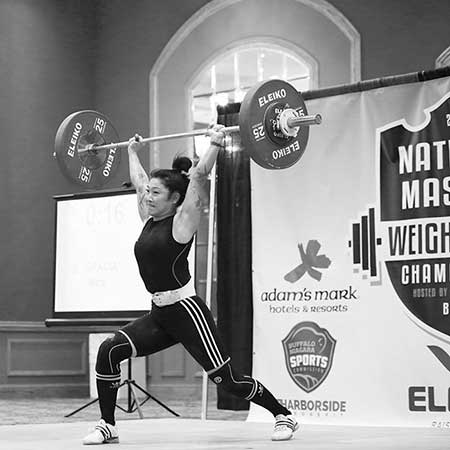
Why train the jerk? Learning how to jerk adds to your overall strength, most specifically, in your legs, back, core, and upper body. Also, by learning how to harness and control the weight overhead, training the jerk will improve other lifts that go overhead such as get-ups, presses, and snatches. If you are competing in the sport of weightlifting, it is a competition lift, but if you don’t compete and yet want to move the most weight in overhead, the jerk is the way to do it.
Basic Concepts of the Jerk
Before we get started, let’s touch on some fundamental necessities for a good jerk.
- Core integrity must be maintained throughout the duration of the lift.
- You must triple extend (ankles, knees, and hips) to optimize your power production. Power comes from the legs not only the arms. Note if you are using kettlebells, you have the option of leaving your heels fixed to the ground only extending through your hips and knees.
- And remember you are pushing yourself down, wedging under the weight versus pushing the weight up.
A Quick How To for the Barbell Split Jerk
- Clean the weight to the rack position and take 2-3 shallow breaths. On the last rep brace your midsection by pushing air into your belly expanding out the sides and into your back. Tighten the weight into your chest.
- Dip straight down bending only at the knees while keeping the heels planted.
- Once you’ve reached about a quarter squat depth, drive through your legs pushing away from the ground and triple extend at the ankles, knees, and hips. Maintain the connection of the weight to your frame until the legs have fully extended. (This is where you are driving the weight with your legs.)
- After triple extension, aggressively extend your arms to full lock out and wedge yourself under the weight by re-bending the legs. If you are split jerking, you will want to ensure that roughly 50% of your weight is on the front leg with a vertical shin and 50% is on the back leg with a bent knee. The hip should remain in line with the back knee and your feet should be at least shoulder width.
- Then simply recover the front foot back and the back foot forward and stand up to complete the lift.
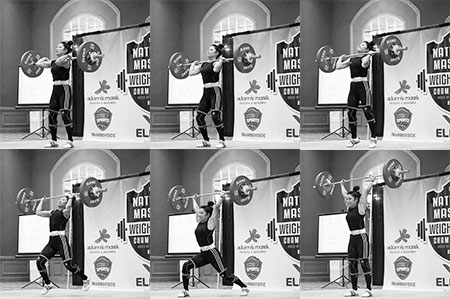
A Quick How To for the Kettlebell Jerk
- Clean a single kettlebell or pair of kettlebells to the rack position. Maintain vertical forearms and straight wrists. Take a shallow breath and brace your midsection by pushing the air into your belly expanding out the sides and into your back.
- Dip straight down bending only at the knees while keeping the heels planted.
- Once you’ve reached about a quarter squat depth, sharply exhale a small breath in concert with your hips, drive through your legs pushing away from the ground and extend at the knees and hips, feet are planted. Note on the kettlebell jerk the ankles may also extend so the heels leave the ground. Maintain the kettlebells in the rack position until the hips and knees have fully extended (This is where you are driving the weight with your legs.)
- After leg extension, aggressively extend your arm or arms to full overhead lock out and push yourself under the weight by re-bending the legs. At this same moment ensure that you are braced to receive the weight by sharply exhaling a small breath in concert with the final catch.
- Then simply stand up to complete the lift.
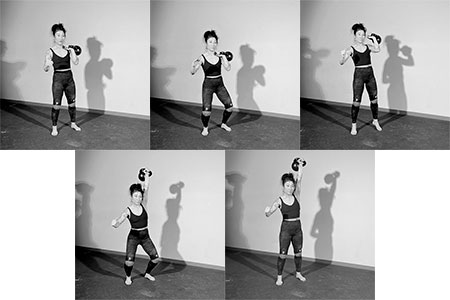
Some More Specific Details
Load Placement:
- There are a few differences in the jerk when done with a barbell versus the kettlebell, namely the load and where it sits on your frame. With the kettlebell, the load sits in the triangle created by your shoulder and vertical forearm. With the barbell it will sit behind your deltoids and above the collarbone.
Grip and Arm Position:
- With the kettlebell, your elbow position will be down and close to your ribs. With a barbell, your elbows will be a bit wider out and considerably higher.
- Hands with the kettlebell will firmly grasp the handle. Hands with a barbell will either be closed around the barbell or slightly open with three or so fingers around the bar. This is based on the lifter’s preference.
Footwork:
- With a kettlebell the footwork is symmetrical, and the heels of the feet can but do not have to leave the ground. In weightlifting this is called a push jerk.
- With a barbell jerk there are a few variations when it comes to footwork.
- The first is similar in nature to the kettlebell jerk we do in StrongFirst where the feet stay symmetrical and the forefoot stays connected to the ground. This is referred to as a push jerk.
- The second is the same as the push jerk but the feet move out to the side and stay symmetrical. This is called a power jerk.
- The third and most common is a unilateral version where the feet elevate after triple extension and replant into a split stance (lunge) position.
- And lastly and least common is a squat jerk where the feet maintain symmetry, but the weight is received and recovered from a full overhead squat. This is rare and requires the most mobility, strength, and overall connection.
A few other noteworthy differences are that with a kettlebell you can choose to load one arm or both. Without going too deep into the benefits of both. Single work is great for balancing out left and right sides and adding variety in terms of load and effort. Double kettlebell work is relentless and is a great way to build muscle, armor, and character.
Lastly, due to the fact that you are holding one object with both hands versus an individual object in each hand, significantly more weight can be moved when jerking the barbell. A strong female, roughly 60kg body weight girevik, can move a pair of 24kg kettlebells overhead. The same athlete could move 140kg overhead at the most elite level.
Ways To Improve Your Jerk
- Having good ankle mobility is a plus. The bend during the dip comes at the knees and ankles not the hips or else your risk falling forward. Not only could this result in losing the weight, but it also redirects force horizontally which is less powerful than directing it vertically.
- Having good thoracic and shoulder mobility is key. In the final position overhead, the weight ideally is in line with your skeleton and your arms locked out. If proper overhead mobility is not achieved, your body will borrow mobility from your elbows or lower back, which is not desirable.
- Working to have a strong core to resist flexion in the dip and drive will allow you to transfer the weight overhead more effectively.
- Front or back squats will improve your legs strength and therefore your ability to produce force in the jerk.
- And finally, a strong overhead position once proper mobility is achieved. You are still holding weight, so having strong wrists, arms, and shoulders is a must.
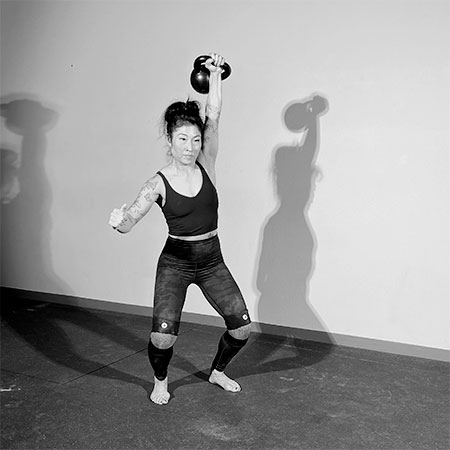
Programming
So, now that you’re hooked and want to train jerks, here are a couple of program suggestions to fine tune the movement. One for a barbell and one for a pair of kettlebells. Note: These programs are to specifically work on the jerk and should be complemented with complex squats and hinge movements. (For clarification, the programs below are written reps/sets, so “Jerk x 3/5” is 5 sets of 3 jerks.)
Barbell:
Kettlebell program adapted from Kettlebell STRONG! by Geoff Neupert:
Conclusion
Remember it takes a combination of leg strength, core integrity, mobility, and technical finesse to execute a jerk. It is not purely an upper body lift but gaining proficiency with it will add to your overall strength and will build robust shoulders. There is not a more efficient and powerful way to move a maximal load overhead than the jerk. A great bonus is it’s by far one of the most exciting ways to move weight and has great transference to other strength lifts.
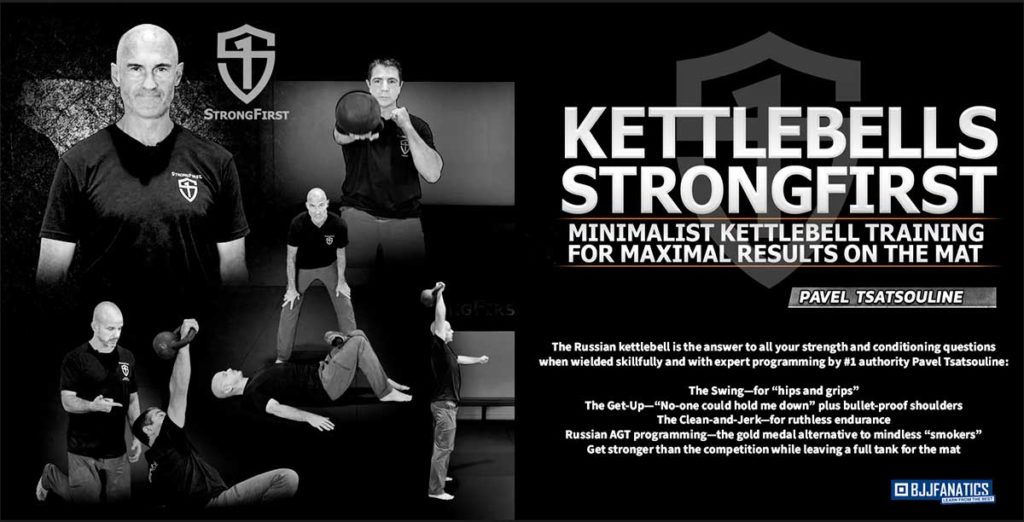
Learn the Kettlebell Jerk and Much More—
and Get into Your Best Fighting Shape
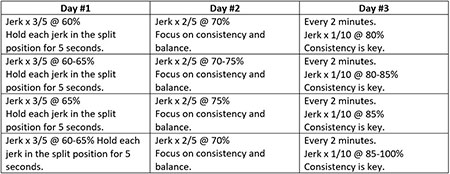
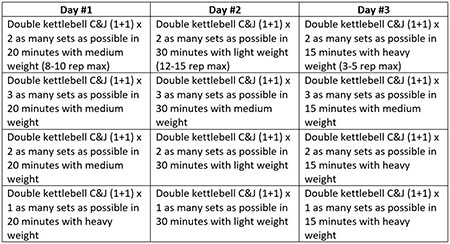
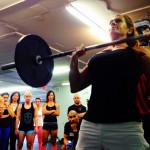
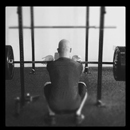
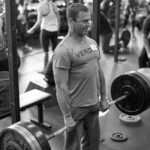
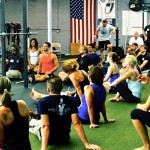
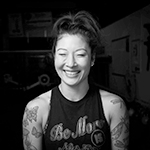

Would you recommend adding the C:J to sports training program specifically baseball?
I’ll be completely honest as power cleans are a great way to develop explosive strength for sports, jerks however require a ton of overhead mobility and demand I think would be too much for someone focusing on baseball. I am also not entirely familiar with the various positional requirements for the sport. If it’s pitching I’d say no. But not sure about other positions. -Mira
Hi Mira,
Thank you for this great article. It’s nice to see that the Jerk has returned to SF publishing as it seemed to be abandoned till Strong! Was brought back and Pavel introduced Kettlebells StrongFirst.
I’’ve Got a question about the kettlebell programming. Does (1+1) mean it’s simply a pair, or clean & jerk for each rep?
Also, this program does not seem to be based on Strong!, it actually resembles other one from Geoff – The Giant more as the time is restricted but the number of sets is open?
Hi Marcin
Thank you for the read! (1+1) means one clean + one jerk. And I am not familiar with Giant but will look at that for sure! Thank you! -Mira
I’ve been training the KB LCCJ for about six months now so it is really interesting to see a like-for-like comparison with the barbell in one article – Thank you.
I’m intrigued to know whether the legs always split the same way, or whether the barbell technique should be practiced both ways?
Thank you for the read! As for any unilateral movement one could always over do it and develop compensation. Normally one would always spilt one sided. But if you train lunges and step back lunges you should be fine.-Mira